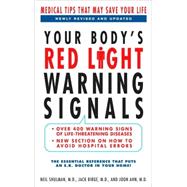
| Introduction: Medical Tips That Can Save Your Life | p. xv |
| How to Use This Book | p. xvii |
| How to Use the Table of Red Light Warning Signals | p. xxi |
| Table of Red Light Warning Signals | p. xxii |
| Body Part-Specific Health Problems (More Common in Adults), Listed from Head to Toe | |
| Head | p. 3 |
| Eyes | p. 27 |
| Ear, Nose, Mouth, Throat, and Neck | p. 34 |
| Arms and Hands | p. 52 |
| Breast | p. 63 |
| Chest Area | p. 69 |
| Belly, Stomach Area, or Abdomen | p. 111 |
| Genitalia | p. 141 |
| Bowel Movement | p. 147 |
| Urine | p. 157 |
| Menstruation (Periods), Menopause, and PMS | p. 166 |
| Groin | p. 173 |
| Hips, Buttocks, Legs, and Ankles | p. 175 |
| Skin | p. 181 |
| Back | p. 201 |
| General Symptoms and Signs (More Common in Adults): Not Body Part-Specific Conditions | |
| Allergic Reactions | p. 209 |
| Blood and Blood Pressure | p. 216 |
| Dehydration | p. 223 |
| Fever | p. 225 |
| Medication | p. 228 |
| Passing Out, Loss of Consciousness | p. 230 |
| Temperature Change | p. 233 |
| Weakness | p. 239 |
| Weight Loss | p. 242 |
| Pregnancy and Postpregnancy | |
| Introduction: Preventive Measures to Increase the Chances of Delivering a Healthy Baby | p. 247 |
| Pediatrics: Body Part-Specific Conditions | |
| Introduction: Childhood Conditions | p. 259 |
| Head | p. 269 |
| Psychological Problems | p. 277 |
| Eyes | p. 281 |
| Throat | p. 283 |
| Arms, Hands, Fingers, and Nails | p. 285 |
| Back | p. 287 |
| Chest | p. 289 |
| Belly | p. 294 |
| Urine | p. 296 |
| Bowel Movement | p. 299 |
| Genitalia | p. 304 |
| Legs | p. 305 |
| Skin and Hair | p. 307 |
| Allergic Reactions | p. 314 |
| Fever | p. 316 |
| Miscellaneous | p. 318 |
| Prevention of Errors in the Hospital | |
| Introduction | p. 327 |
| Hospital Policy | p. 329 |
| Sanitization | p. 331 |
| Mistaken Identity and Communication Errors | p. 333 |
| Medication | p. 336 |
| Secondary Conditions that You Can Develop in the Hospital and How to Avoid Them | p. 338 |
| Accidents | p. 342 |
| Appendixes | |
| Emergency Medical Treatment | p. 343 |
| Choking | p. 343 |
| Cardiopulmonary Resuscitation (CPR) and the Use of Automated External Defibrillators (AEDs) | p. 350 |
| Self-Examinations | p. 364 |
| Breast Exam | p. 364 |
| Testicular Exam | p. 367 |
| Valuable Preventive Screenings (Listed from Head to Toe) | p. 369 |
| Taking a Child's Temperature | p. 393 |
| Index | p. 401 |
| Table of Contents provided by Ingram. All Rights Reserved. |
The New copy of this book will include any supplemental materials advertised. Please check the title of the book to determine if it should include any access cards, study guides, lab manuals, CDs, etc.
The Used, Rental and eBook copies of this book are not guaranteed to include any supplemental materials. Typically, only the book itself is included. This is true even if the title states it includes any access cards, study guides, lab manuals, CDs, etc.
Excerpted from Your Body's Red Light Warning Signals, revised Edition: Medical Tips That May Save Your Life by Neil Shulman, Jack Birge, Joon Ahn
All rights reserved by the original copyright owners. Excerpts are provided for display purposes only and may not be reproduced, reprinted or distributed without the written permission of the publisher.